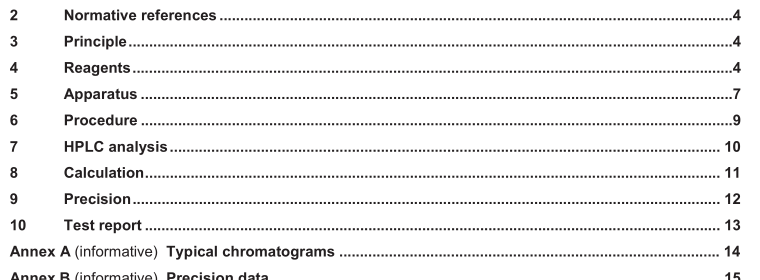EN 15835:2010 – Foodstuffs – Determination of ochratoxin A in cereal based foods for infants and young children – HPLC method with immunoaffinity column cleanup and fluorescence detection

1 Scope
This European Standard specifies a method for the determination of ochratoxin A in cereal based foods for infants and young children by high performance liquid chromatography (HPLC) with immunoaffinity column cleanup and fluorescence detection. This method has been validated in an interlaboratory study via the analysis of both naturally contaminated and spiked samples ranging from 0,050 µg/kg to 0,217 µg/kg.
For further information on the validation see Clause 8 and Annex B. Additional studies have shown that this method is applicable to cereal based baby foods containing 8 different types of cereals, honey and cocoa, at levels up to 3,540 µg/kg, see Annex C and [6]. WARNING — The use of this standard can involve hazardous materials, operations and equipment. This standard does not purport to address all the safety problems associated with its use. It is the responsibility of the user of this standard to establish appropriate safety and health practices and determine the applicability of regulatory limitations prior to use.
2 Normative references The following referenced documents are indispensable for the application of this document. For dated references, only the edition cited applies. For undated references, the latest edition of the referenced document (including any amendments) applies. EN ISO 3696:1995, Water for analytical laboratory use ― Specification and test methods (ISO 3696:1987)
3 Principle A test portion is extracted with tert-butyl methyl ether after addition of 0,5 mol/l phosphoric acid / 2 mol/l sodium chloride solution. The extract is evaporated and redissolved in methanol and phosphate buffered saline (PBS) solution. After removal of lypophilic compounds with hexane, the extract is applied to an immunoaffinity column containing antibodies specific to ochratoxin A. The toxin is eluted from the column with methanol. Ochratoxin A is determined by HPLC with enhanced fluorescence detection involving post column reaction with ammonia. NOTE Some investigations indicate that HPLC can be also performed without the use of ammonia although this results in at least a two-fold decrease of the response for ochratoxin A. In this case, the fluorescence detection conditions need to be changed (excitation wavelength = 333 nm, emission wavelength = 460 nm).
4 Reagents
4.1 General Use only reagents of recognized analytical grade and water complying with grade 1 of EN ISO 3696:1995, unless otherwise specified. Solvents shall be of quality for HPLC analysis. Commercially available solutions with equivalent properties to those listed may be used. WARNING — Dispose of waste solvents according to applicable environmental rules and regulations. Decontamination procedures for laboratory wastes have been reported by the International Agency for Research on Cancer (IARC), see [4].
EN 15835:2010 – Foodstuffs – Determination of ochratoxin A in cereal based foods for infants and young children – HPLC method with immunoaffinity column cleanup and fluorescence detection